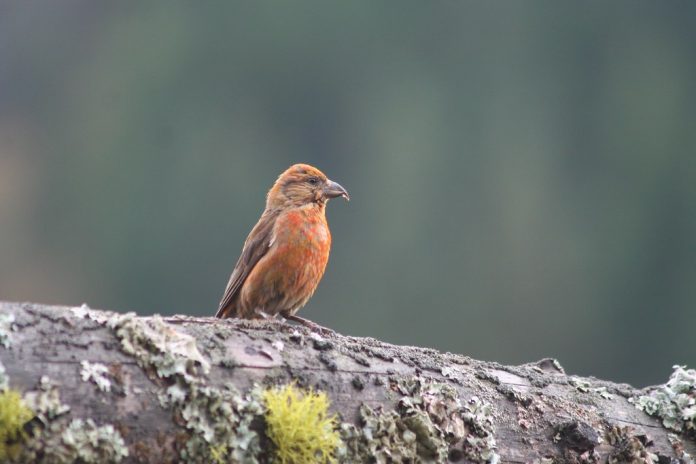The size of the Common Crossbill (Loxia curvirostra) is about 16.5 cm in length. This red crossbill is a relatively large, plump finch of coniferous forests, with a relatively short, deeply cleft tail, large head, and parrot-like feeding habits. At close quarters, the very distinguishing large bill with its crossed mandible tips (an exclusive adaptation amongst crossbill species for extracting seeds from cones) may be discerned. Its plumages are very unpredictable, according to age and sex.
The adult male in full plumage is brick-red overall, with dark grayish-brown wings and tail; some attain full red plumage in the second calendar year, but others resemble females for a further year; indeed, there is much individual variation, and aging of some birds can be difficult, even many apparently adult males appearing yellowish or orange-red.
A small minority of adult males are mottled greenish-yellow and red. The adult female is in general rather dull greenish-yellow, with a yellower rump (quite obvious in flight) and weakly streaked upper parts. Some look mainly dull and grayish-tinged. First-years mostly closely resemble adult females after the first molt in the summer or autumn of the first calendar year, but some males have a golden-yellow body color while others have some orange-red feathering mixed with greenish-yellow.
The juvenile is grayish-brown, streaked darker overall, and lacks the yellowish rump of an adult female, and fresh feathers of the wing show pale fringes giving the resemblance of faint wing bars, but hardly enough to create confusion with Two-barred Crossbill. Very rarely, however, birds with buffish-white wing bars and even tips to tertials occur, even among adult males, and these ‘rubrifasciata’ individuals cause real problems with records of out-of-range Two-barred.
The young juveniles lack the cross-tipped mandibles of older birds but soon acquire them after leaving the nest. For distinctions from very similar Parrot and Scottish Crossbills, see those species. Common Crossbills are frequently very tame and are very sociable, with flocks working the cones of various species of conifer, although in Northern Europe they show a marked preference for spruce.
Common Crossbill call is a characteristically loud, explosive ‘chip-chip-chip’ or ‘glip-glip-glip’, like to call note of European Greenfinch but louder and harder; once learned, is quite distinctive. The bird has more than a few other calls of a conversational nature, including a harsh, muffled ‘chewk’ when nervous or alarmed. Flight calls a ringing ‘jip-jip-jip’.
Common Crossbill song is reminiscent of that of European Greenfinch, but more varied, with trills and warbling phrases intermingled with call notes. Common Crossbill has generally rather slight 5 races. These races are widespread in the European region, but other subspecies remote on Mediterranean islands and in North Africa are barely separable in the field except by range, though males of these birds tend to become less red when fully adult.
Race guillemardi (Cyprus and Turkey to Caucasus and Crimea) has a large bill, thus recalling the Scottish Crossbill, but, owing to a restricted range of the latter, hardly likely to be confused. Common Crossbill is locally fairly common. (Breeding is sporadic in most of the extreme west of the European range. In addition to the mapped range, has bred Ireland, and Israel.
Subject to ‘irruptions’ into areas where usually absent, usually from late summer into winter, at intervals of several years; reaches south to Israel during such irruptions.)
Coniferous woodland, with a preference for spruce in the north, but will feed among pines; indeed, populations in the south of our region, where spruces are absent, are birds of pine forest. Read More – Pied Butcherbird (Cracticus nigrogularis)

